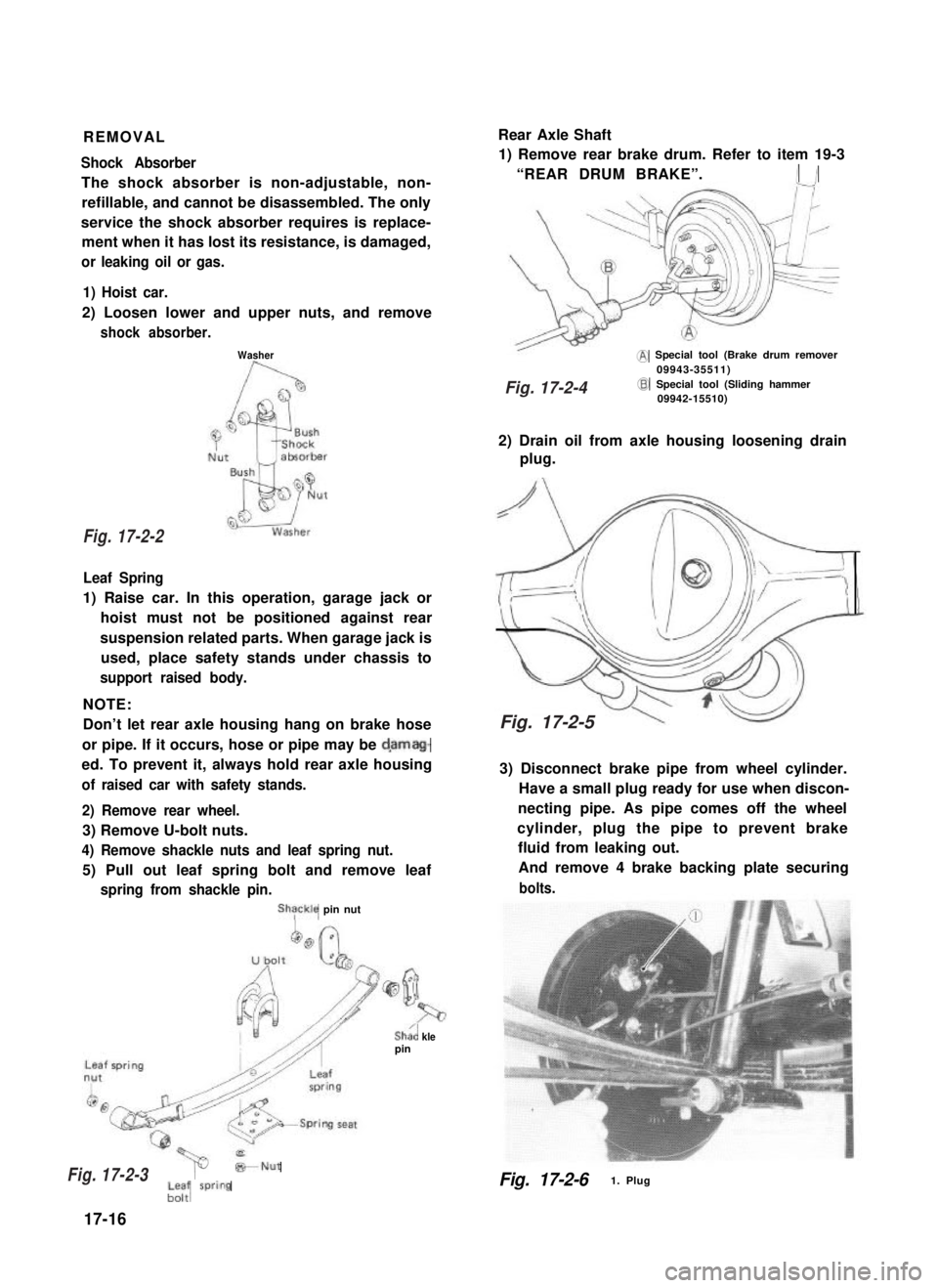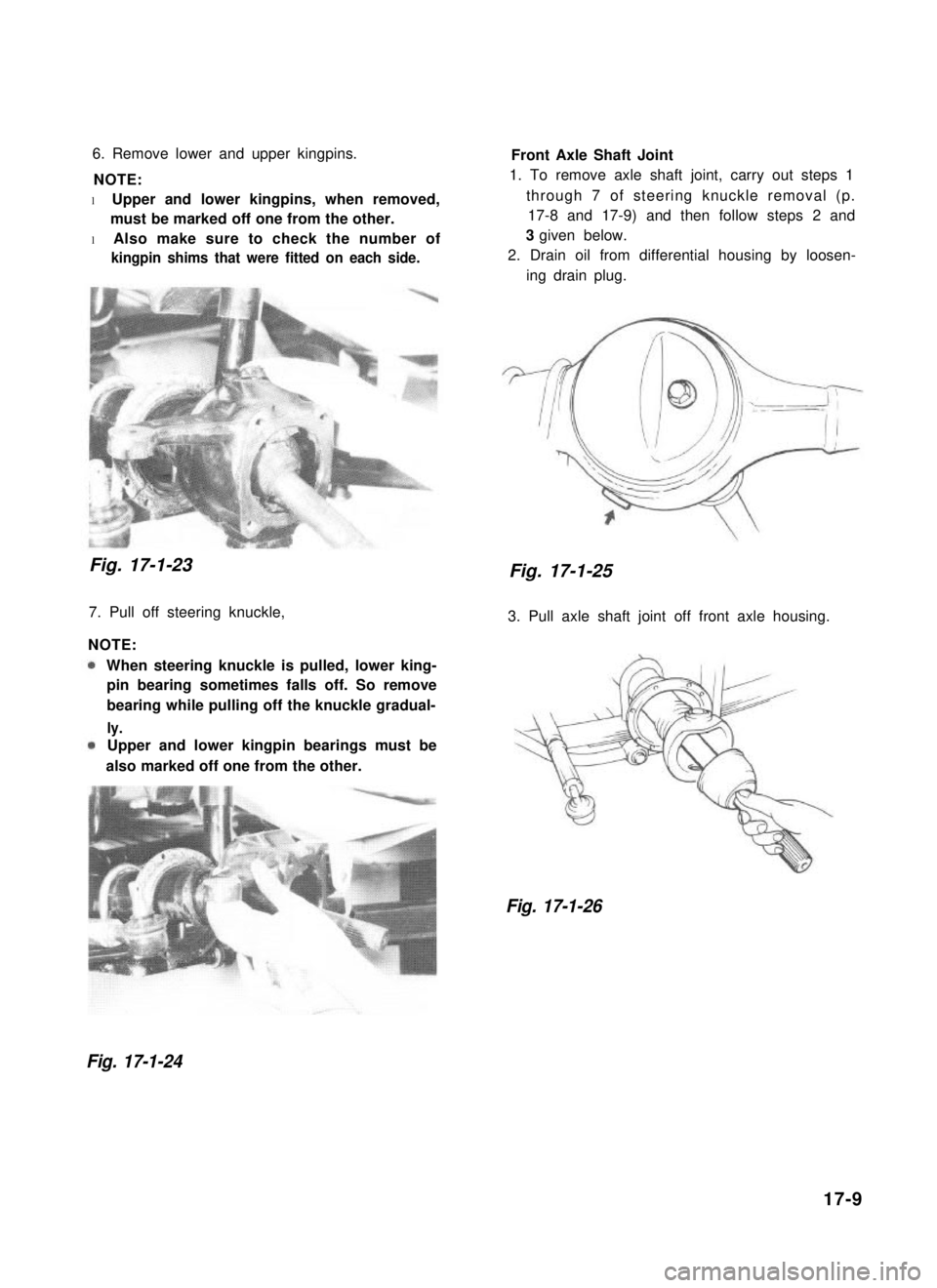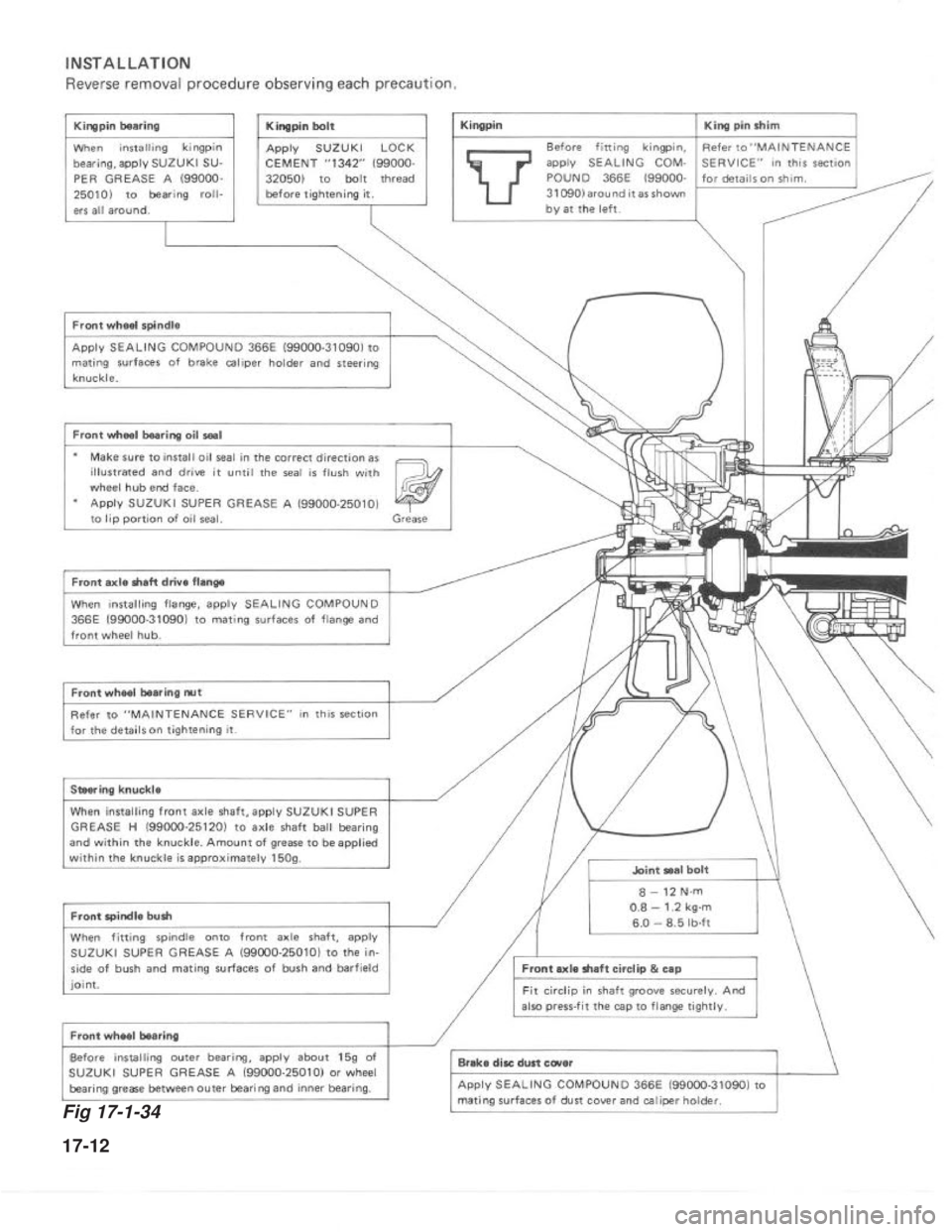SUZUKI GRAND VITARA 1987 Service Repair Manual
GRAND VITARA 1987
SUZUKI
SUZUKI
https://www.carmanualsonline.info/img/20/57437/w960_57437-0.png
SUZUKI GRAND VITARA 1987 Service Repair Manual
Trending: technical specifications, headlights, seat adjustment, oil capacities, oil, ESP, brake pads
Page 341 of 962
[For car not equipped with free wheeling hub]
5. Remove the front axle shaft cap.
6. Remove the circlip retaining the front axle
shaft drive flange on front drive shaft, using
the circlip remover @.
Fig. 17-1-12-3 @ Circlip Remover
7. Loosen securing bolts of front axle shaft
drive flange and take off drive flange.
Fig. 17-1-13
8. Straighten bent part of lock washer and
remove wheel bearing lock nut with special
tool @I.
Fig. 17-1-15 Special tool @
(Front Wheel Bearing Nut Socket
Wrench 09941-58010)
9. After loosening front wheel bearing nut
with the same special tool @I as mentioned
in the foregoing step 8, take nut and washer
off the front wheel spindle.
\
Fig. 17-1-16
10. Pull front wheel hub off the front wheel
spindle.
Fig. 17-1-17
17-7Fig. 17-1-14
Page 342 of 962
11. Remove oil seal and outer race of inner
bearing or outer bearing from wheel hub.
Fig. 17-1-18
Steering Knuckle
1. Remove front wheel hub, referring to steps 1
to 10 of foregoing front wheel hub and
bearing removal.
2. Loosen bolts securing kingpins (upper &
lower). At this point, king pins mustn’t be
removed.
Fig. 17-1-19
3. Remove disc dust cover, caliper holder and
wheel spindle.
Fig. 17-1-20
4.Remove tie rod end castle nut and disconnect
tie rod end from steering knuckle with
special tool @.
Fig. 17-1-21 Special tool @ (Tie Rod End
Remover 09913-65210)
5. Remove joint seal bolts. Then remove oil seal
cover, pad, oil seal and retainer from knuckle.
Fig. 17-1-22 17-8
Page 343 of 962
6. Remove lower and upper kingpins.
NOTE:
l Upper and lower kingpins, when removed,
must be marked off one from the other.
l Also make sure to check the number of
kingpin shims that were fitted on each side.
Front Axle Shaft Joint
1. To remove axle shaft joint, carry out steps 1
through 7 of steering knuckle removal (p.
17-8 and 17-9) and then follow steps 2 and
3 given below.
2. Drain oil from differential housing by loosen-
ing drain plug.
Fig. 17-1-23
7. Pull off steering knuckle,
NOTE:
When steering knuckle is pulled, lower king-
pin bearing sometimes falls off. So remove
bearing while pulling off the knuckle gradual-
ly.
Upper and lower kingpin bearings must be
also marked off one from the other.
Fig. 17-1-25
3. Pull axle shaft joint off front axle housing.
Fig. 17-1-26
Fig. 17-1-24
17-9
Page 344 of 962
INSPECTION OF COMPONENT
Stabilizer and its Bush
Inspect stabilizer for damage or deformation.
If defective, replace.
Inspect bushes for damage, wear or deteriora-
tion. If defective, replace.
8
Barfield Joint
To be checked on this joint is its axial play,
which shows up when a push-and-pull motion is
given to live axle shaft and wheel spindle held in
both hands, as shown in figure. There should be
no play at all but a play of up to 1.5 mm (0.06
in.) is permissible. If play exceeds service limit,
replace it.
\/
Leaf Spring Bushes
Inspect for wear and breakage. If found defec-
tive, replace.
Front Wheel Bearing
Check front wheel bearing rollers for damage.
If anything is found wrong, replace bearing with
a new one.
17-10
Fig. 17-1-27
Fig. 17-1-28
Fig. 17-1-30
Fig. 17-1-29
Page 345 of 962
Kingpins and Bearings
Inspect each kingpin closely for dents, signs of
cracking, distortion or any other damage.
Replace the kingpins found in defective condi.
tion.
Check the oil seal for wear or damage. If defec-
tive, replace with new one.
Fig. 17-1-31
Check the kingpin bearings for damage. If
anything is found wrong, replace the bearing
with new one.
Fig. 17-1-32
Steering Knuckle Oil Seal
The oil seal used at the spherical sliding joint
between the knuckle and the inner case accom-
plishes the additional purposes of keeping out
road dust and of acting as the damper for the
steering handwheel.As the wear of this seal
advances, its damping effect decreases and thus
make the front wheel develop a tendency to
“shimmy”not only that road dust begins to
creep into the sliding clearance to promote the
wear of the spherical sliding surfaces.
17-11
Fig. 17-1-33
Page 346 of 962
Page 347 of 962
Page 348 of 962
Stabilizer
Stabilizer bolt & lock washerI
18-28N.m
1.8 - 2.8 kg-m13.5 - 20.0 lb-ft
l Tighten to the following specified torque
in unloaded condition.70 - 90 N.m
l
7.0 - 9.0 kg-m
51 .O - 65.0 lb-ftInstall lock washer in body outer side.
1 Stabilizer nut
qPaint
Tighten tothe following specified
torque in unloaded condition.22-35 N.m
2.2-3.5 kg-m
16.0-25.0 lb-ft
Stabilizer mount bush
View A
Install stabilizer mount bushes (right & left) by aligningthem with painted positions on stabilizer respectively.
Fig. 17-1-35
17-14
Page 349 of 962
17-2. REAR SUSPENSION
GENERAL DESCRIPTION
The rear suspension consists of leaf springs, axle housing, axle shafts and shock absorbers as shown below.
The leaf springs are attached to the chassis frame through rubber bushes located at their both ends as
shown. The axle housing is installed on the right and left leaf springs by means of spring seats and U bolts.
The two shock absorbers (right & left) are installed with their lower ends attached to the spring seats
and the upper ends to the chassis frame, all through rubber bushes.
1. Leaf spring10.Bush
2.Shackle plate inner11.Axle housing
3.Shackle plate outer12.Axle shaft
4.Shackle bush13.Bearing
5.U bolt14.Bearing retainer ring
6.Spring bumper15.Oil seal
7.Spring seat16.Oil sealprotector
8. Spring bush9.Shock absorber
t-lg.
17-15
Fig 17-2-7
Page 350 of 962

REMOVALRear Axle Shaft
Shock Absorber
The shock absorber is non-adjustable, non-
refillable, and cannot be disassembled. The only
service the shock absorber requires is replace-
ment when it has lost its resistance, is damaged,
or leaking oil or gas.
1) Remove rear brake drum. Refer to item 19-3
“REAR DRUM BRAKE”.I /
1) Hoist car.
2) Loosen lower and upper nuts, and remove
shock absorber.
Washer@ Special tool (Brake drum remover09943-35511)
Leaf Spring
1) Raise car. In this operation, garage jack or
hoist must not be positioned against rear
suspension related parts. When garage jack is
used, place safety stands under chassis to
support raised body.
NOTE:
Don’t let rear axle housing hang on brake hose
or pipe. If it occurs, hose or pipe may be d,amag-
ed. To prevent it, always hold rear axle housing
of raised car with safety stands.
2) Remove rear wheel.
3) Remove U-bolt nuts.
4) Remove shackle nuts and leaf spring nut.
5) Pull out leaf spring bolt and remove leaf
spring from shackle pin.
ShTckle pin nut
Sha’, klepin
@Special tool (Sliding hammer09942-15510)
2) Drain oil from axle housing loosening drain
plug.
3) Disconnect brake pipe from wheel cylinder.
Have a small plug ready for use when discon-
necting pipe. As pipe comes off the wheel
cylinder, plug the pipe to prevent brake
fluid from leaking out.
And remove 4 brake backing plate securing
bolts.
*Nut
;-; wring
17-16
Fig. 17-2-61. Plug
Fig. 17-2-2
Fig. 17-2-3
Fig. 17-2-4
Fig. 17-2-5
Trending: water pump, boot, jump cable, four wheel drive, air bleeding, load capacity, warning
![SUZUKI GRAND VITARA 1987 Service Repair Manual [For car not equipped with free wheeling hub]
5. Remove the front axle shaft cap.
6. Remove the circlip retaining the front axle
shaft drive flange on front drive shaft, using
the circlip remover @.
F SUZUKI GRAND VITARA 1987 Service Repair Manual [For car not equipped with free wheeling hub]
5. Remove the front axle shaft cap.
6. Remove the circlip retaining the front axle
shaft drive flange on front drive shaft, using
the circlip remover @.
F](/img/20/57437/w960_57437-340.png)








